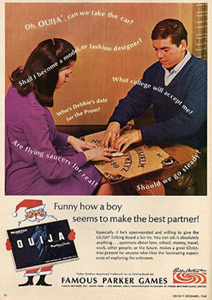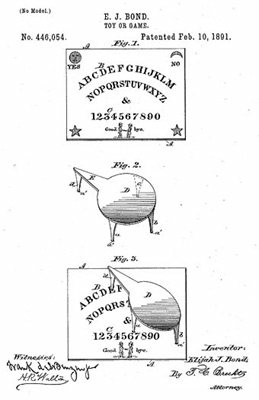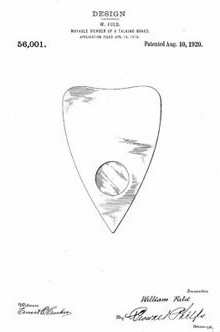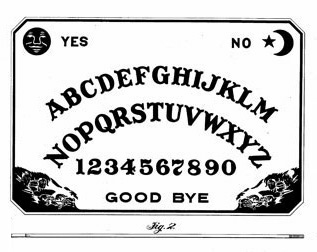 Believe it or not, there are numerous patents for the most popular device supposedly used to communicate with those in the spirit world. The device wasn’t really invented by any of the patent holders, instead it was refined. A Ouija board is used by putting your fingertips on the planchette or indicator and allowing the spirits to guide the planchette around the board. This idea was not new to the Ouija board. “Automatic writing” which was practiced by the ancient Chinese was a process of producing writing utilizing a planchette. Supposedly, the hands of the writer were guided by forces beyond themselves.
Believe it or not, there are numerous patents for the most popular device supposedly used to communicate with those in the spirit world. The device wasn’t really invented by any of the patent holders, instead it was refined. A Ouija board is used by putting your fingertips on the planchette or indicator and allowing the spirits to guide the planchette around the board. This idea was not new to the Ouija board. “Automatic writing” which was practiced by the ancient Chinese was a process of producing writing utilizing a planchette. Supposedly, the hands of the writer were guided by forces beyond themselves.
In the mid-nineteenth century, spiritualist were everywhere. Spiritualists began holding seances and looking for ways to communicate with the dead. The talking board was among the ways people were attempting to talk with spirits. The first patent for one these talking boards was granted to Adolphus Theodore Wagner, on January 23, 1854 in London, England.
 It was more than thirty years until a patent would be filed in the United States. Businessmen Elijah Bond and Charles Kennard decided to capitalize on the popularity of these new talking boards and filed for a patent on on May 28, 1890. They received patent number 446,054 on February 10, 1891 for a toy or game.
It was more than thirty years until a patent would be filed in the United States. Businessmen Elijah Bond and Charles Kennard decided to capitalize on the popularity of these new talking boards and filed for a patent on on May 28, 1890. They received patent number 446,054 on February 10, 1891 for a toy or game.
In 1901, William Fuld, an employee of Charles Kennard, took over the production of the talking board under the name “Ouija.” Kenard claimed the name “Ouija,” revealed to him by the board was an ancient Egyptian word meaning “good luck.” Fuld instead said the name was an combination of the French and German words for yes.
From 1901 to 1996, the Fuld name was synonymous with the Ouija board. During that time, five Fuld family members held patents, trademarks or copyrights on the board. Some of these patents and trademarks include:
 US Trademark No. 18,919 granted on February 3, 1891 for the Ouija logo
US Trademark No. 18,919 granted on February 3, 1891 for the Ouija logo
 Design Patent No. 56,001 issued on August 10, 1920 for a design for the movable member of a talking-board
Design Patent No. 56,001 issued on August 10, 1920 for a design for the movable member of a talking-board
The design of the Ouija panchette still matches the illustration in this patent.

U.S. Copyright No. 526,559 granted on March 27, 1919 for the directions to the Ouija
William Fuld was attempting to protect the directions which were once of the most copied part of the board by copyrighting them.

US Design Patent No. 114,534 issued May 2, 1939
The look of the board in this patent is very similar to the design of the board today.
These and the many other patents and trademarks held by the Fuld family were used in the lawsuits brought about to protect their rights to the Ouija board. They were the manufacturers of the Ouija board and they used this protection against those who tried to manufacture copycat boards.
On February 24,1966, Parker Brothers acquired William Fuld Inc and all of the patents, trademarks and copyrights to the Ouija Board. Today the Ouija board is still the most popular of various talking boards sold.
Is it only a game? Who knows? Patenting it certainly wasn’t.
It has always been mysterious. It has always been mystifying. Sit opposite your partner and rest your fingers lightly on the planchette. Now ask your question. Concentrate very hard…and watch as the answer is revealed in the message window. Will it tell you YES…or NO? Will it give you a NUMBER…or SPELL out the answer? Ask any question you want. Ouija will answer. It’s only a game isn’t it?
From the Parker Brothers Ouija Board
